Canada Immigration Policy: Evolution, Structure, and Impact
VerifiedAdded on 2023/01/16
|5
|1069
|47
Report
AI Summary
This report provides a comprehensive analysis of Canada's immigration policy, tracing its evolution from the 19th century to the present day. It explores the historical context, including the initial focus on expansion and the shift towards more controlled immigration policies. The report examines the structure of Canadian immigration, highlighting the three main categories: economic, family reunification, and refugees. It delves into the economic class, emphasizing the point system and the importance of skills. Family reunification policies, including recognition of same-sex couples, are also discussed. Additionally, the report provides an overview of the Canadian immigration system, including the Express Entry, Provincial Nominee Program, Quebec-Selected Skilled Workers, Start-up Visa Program, and Caregiver Program. It concludes with a summary of the immigration application process and the role of the Canadian Immigration and Citizenship department.
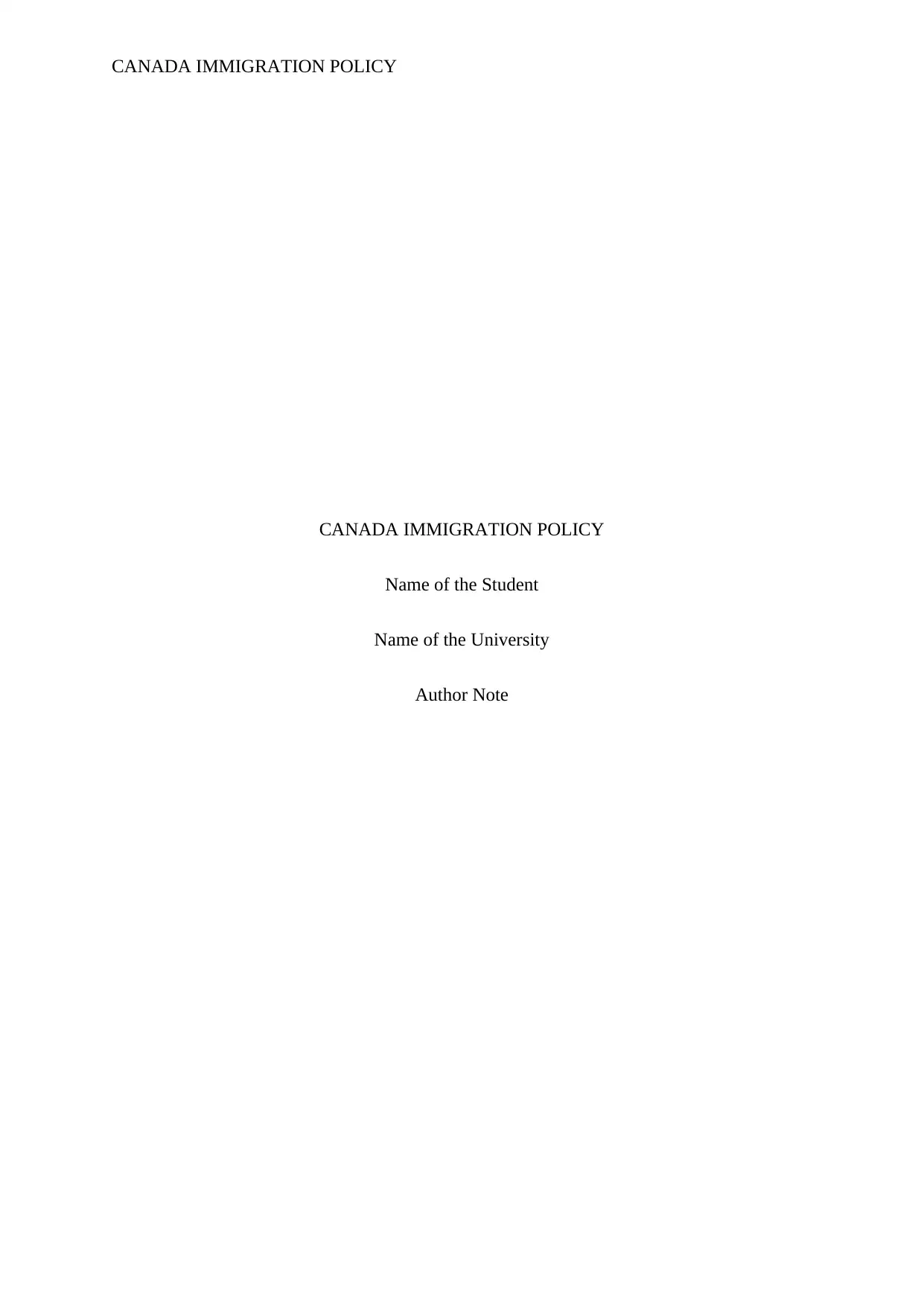
CANADA IMMIGRATION POLICY
CANADA IMMIGRATION POLICY
Name of the Student
Name of the University
Author Note
CANADA IMMIGRATION POLICY
Name of the Student
Name of the University
Author Note
Paraphrase This Document
Need a fresh take? Get an instant paraphrase of this document with our AI Paraphraser
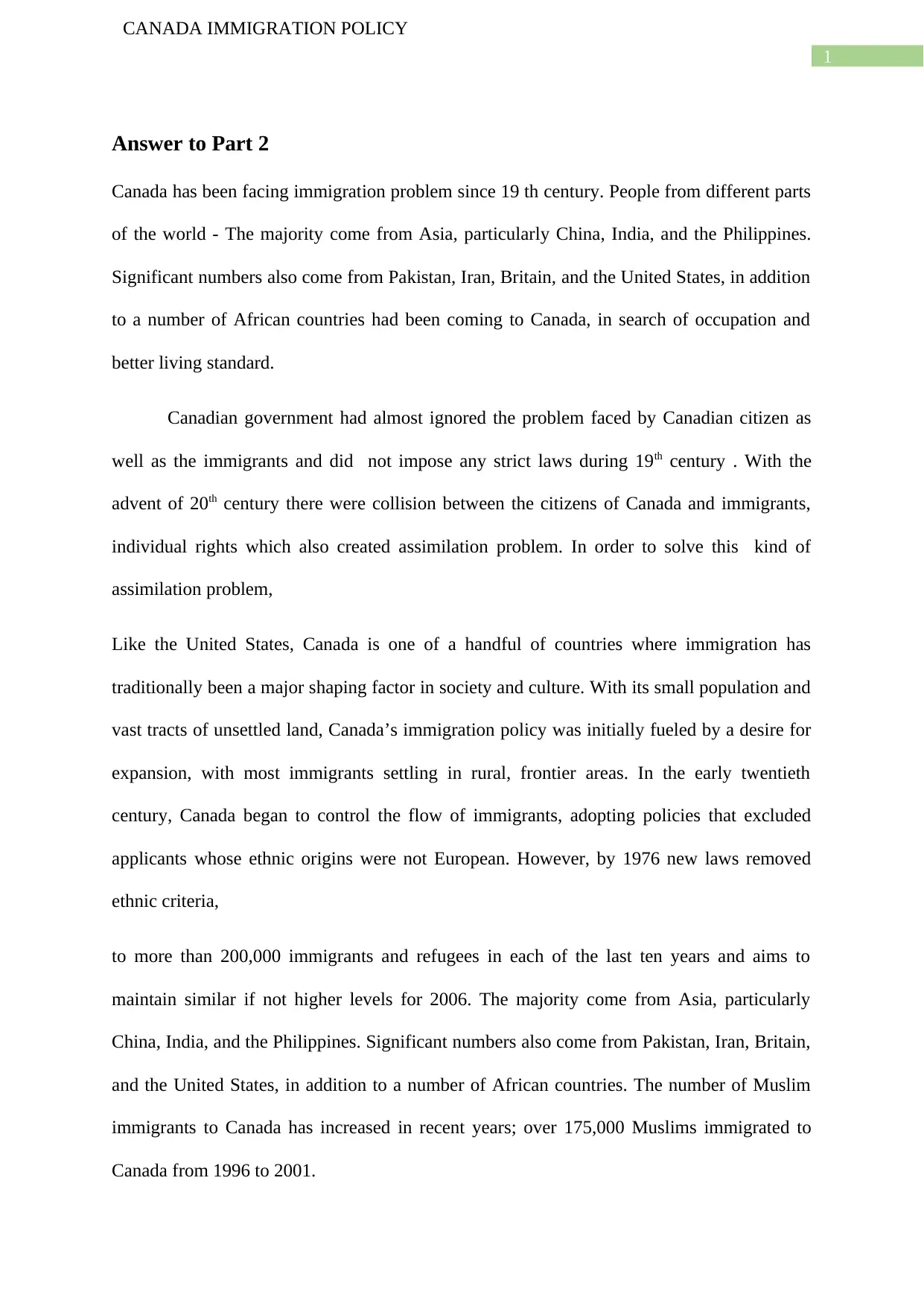
1
CANADA IMMIGRATION POLICY
Answer to Part 2
Canada has been facing immigration problem since 19 th century. People from different parts
of the world - The majority come from Asia, particularly China, India, and the Philippines.
Significant numbers also come from Pakistan, Iran, Britain, and the United States, in addition
to a number of African countries had been coming to Canada, in search of occupation and
better living standard.
Canadian government had almost ignored the problem faced by Canadian citizen as
well as the immigrants and did not impose any strict laws during 19th century . With the
advent of 20th century there were collision between the citizens of Canada and immigrants,
individual rights which also created assimilation problem. In order to solve this kind of
assimilation problem,
Like the United States, Canada is one of a handful of countries where immigration has
traditionally been a major shaping factor in society and culture. With its small population and
vast tracts of unsettled land, Canada’s immigration policy was initially fueled by a desire for
expansion, with most immigrants settling in rural, frontier areas. In the early twentieth
century, Canada began to control the flow of immigrants, adopting policies that excluded
applicants whose ethnic origins were not European. However, by 1976 new laws removed
ethnic criteria,
to more than 200,000 immigrants and refugees in each of the last ten years and aims to
maintain similar if not higher levels for 2006. The majority come from Asia, particularly
China, India, and the Philippines. Significant numbers also come from Pakistan, Iran, Britain,
and the United States, in addition to a number of African countries. The number of Muslim
immigrants to Canada has increased in recent years; over 175,000 Muslims immigrated to
Canada from 1996 to 2001.
CANADA IMMIGRATION POLICY
Answer to Part 2
Canada has been facing immigration problem since 19 th century. People from different parts
of the world - The majority come from Asia, particularly China, India, and the Philippines.
Significant numbers also come from Pakistan, Iran, Britain, and the United States, in addition
to a number of African countries had been coming to Canada, in search of occupation and
better living standard.
Canadian government had almost ignored the problem faced by Canadian citizen as
well as the immigrants and did not impose any strict laws during 19th century . With the
advent of 20th century there were collision between the citizens of Canada and immigrants,
individual rights which also created assimilation problem. In order to solve this kind of
assimilation problem,
Like the United States, Canada is one of a handful of countries where immigration has
traditionally been a major shaping factor in society and culture. With its small population and
vast tracts of unsettled land, Canada’s immigration policy was initially fueled by a desire for
expansion, with most immigrants settling in rural, frontier areas. In the early twentieth
century, Canada began to control the flow of immigrants, adopting policies that excluded
applicants whose ethnic origins were not European. However, by 1976 new laws removed
ethnic criteria,
to more than 200,000 immigrants and refugees in each of the last ten years and aims to
maintain similar if not higher levels for 2006. The majority come from Asia, particularly
China, India, and the Philippines. Significant numbers also come from Pakistan, Iran, Britain,
and the United States, in addition to a number of African countries. The number of Muslim
immigrants to Canada has increased in recent years; over 175,000 Muslims immigrated to
Canada from 1996 to 2001.
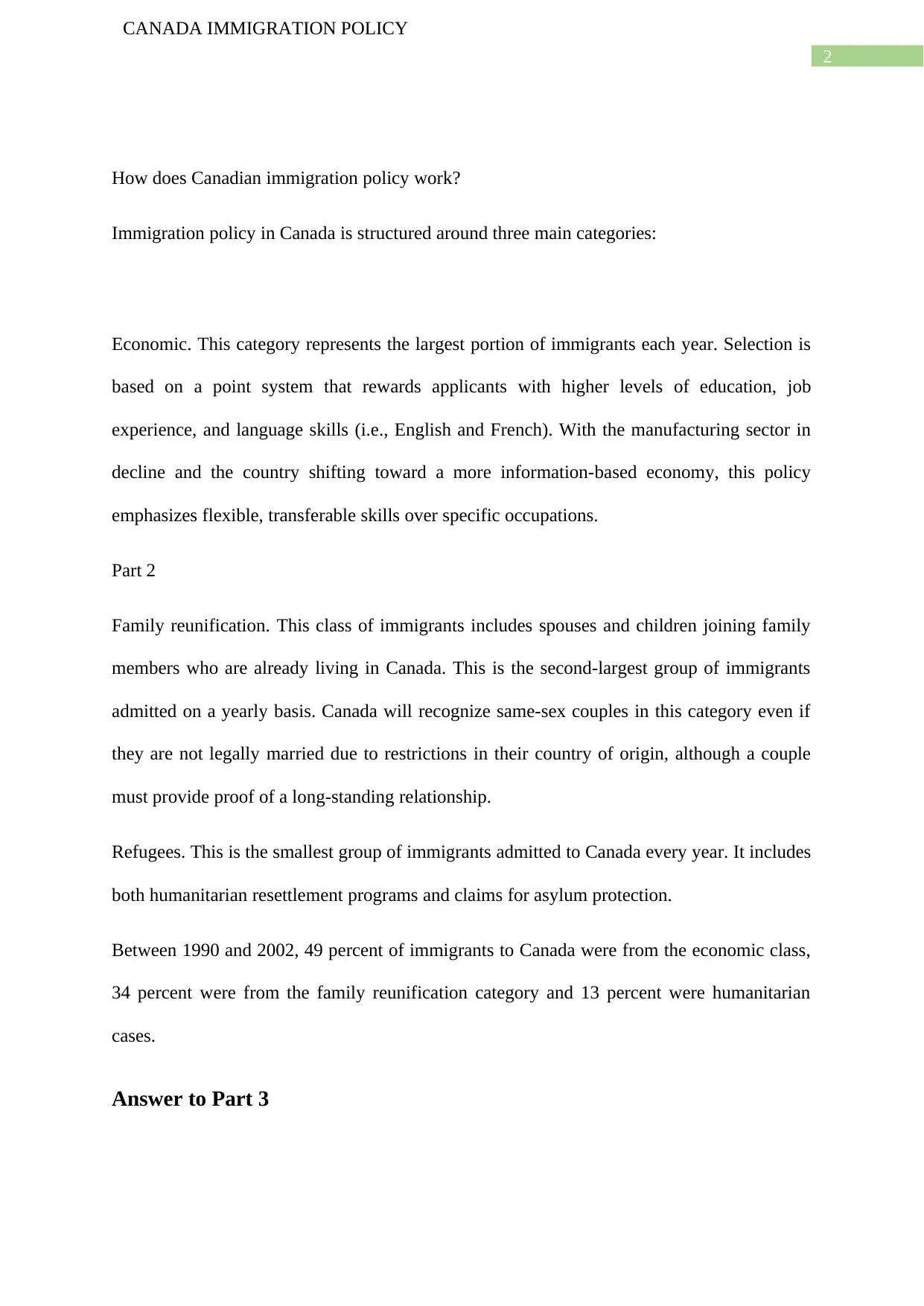
2
CANADA IMMIGRATION POLICY
How does Canadian immigration policy work?
Immigration policy in Canada is structured around three main categories:
Economic. This category represents the largest portion of immigrants each year. Selection is
based on a point system that rewards applicants with higher levels of education, job
experience, and language skills (i.e., English and French). With the manufacturing sector in
decline and the country shifting toward a more information-based economy, this policy
emphasizes flexible, transferable skills over specific occupations.
Part 2
Family reunification. This class of immigrants includes spouses and children joining family
members who are already living in Canada. This is the second-largest group of immigrants
admitted on a yearly basis. Canada will recognize same-sex couples in this category even if
they are not legally married due to restrictions in their country of origin, although a couple
must provide proof of a long-standing relationship.
Refugees. This is the smallest group of immigrants admitted to Canada every year. It includes
both humanitarian resettlement programs and claims for asylum protection.
Between 1990 and 2002, 49 percent of immigrants to Canada were from the economic class,
34 percent were from the family reunification category and 13 percent were humanitarian
cases.
Answer to Part 3
CANADA IMMIGRATION POLICY
How does Canadian immigration policy work?
Immigration policy in Canada is structured around three main categories:
Economic. This category represents the largest portion of immigrants each year. Selection is
based on a point system that rewards applicants with higher levels of education, job
experience, and language skills (i.e., English and French). With the manufacturing sector in
decline and the country shifting toward a more information-based economy, this policy
emphasizes flexible, transferable skills over specific occupations.
Part 2
Family reunification. This class of immigrants includes spouses and children joining family
members who are already living in Canada. This is the second-largest group of immigrants
admitted on a yearly basis. Canada will recognize same-sex couples in this category even if
they are not legally married due to restrictions in their country of origin, although a couple
must provide proof of a long-standing relationship.
Refugees. This is the smallest group of immigrants admitted to Canada every year. It includes
both humanitarian resettlement programs and claims for asylum protection.
Between 1990 and 2002, 49 percent of immigrants to Canada were from the economic class,
34 percent were from the family reunification category and 13 percent were humanitarian
cases.
Answer to Part 3
⊘ This is a preview!⊘
Do you want full access?
Subscribe today to unlock all pages.

Trusted by 1+ million students worldwide
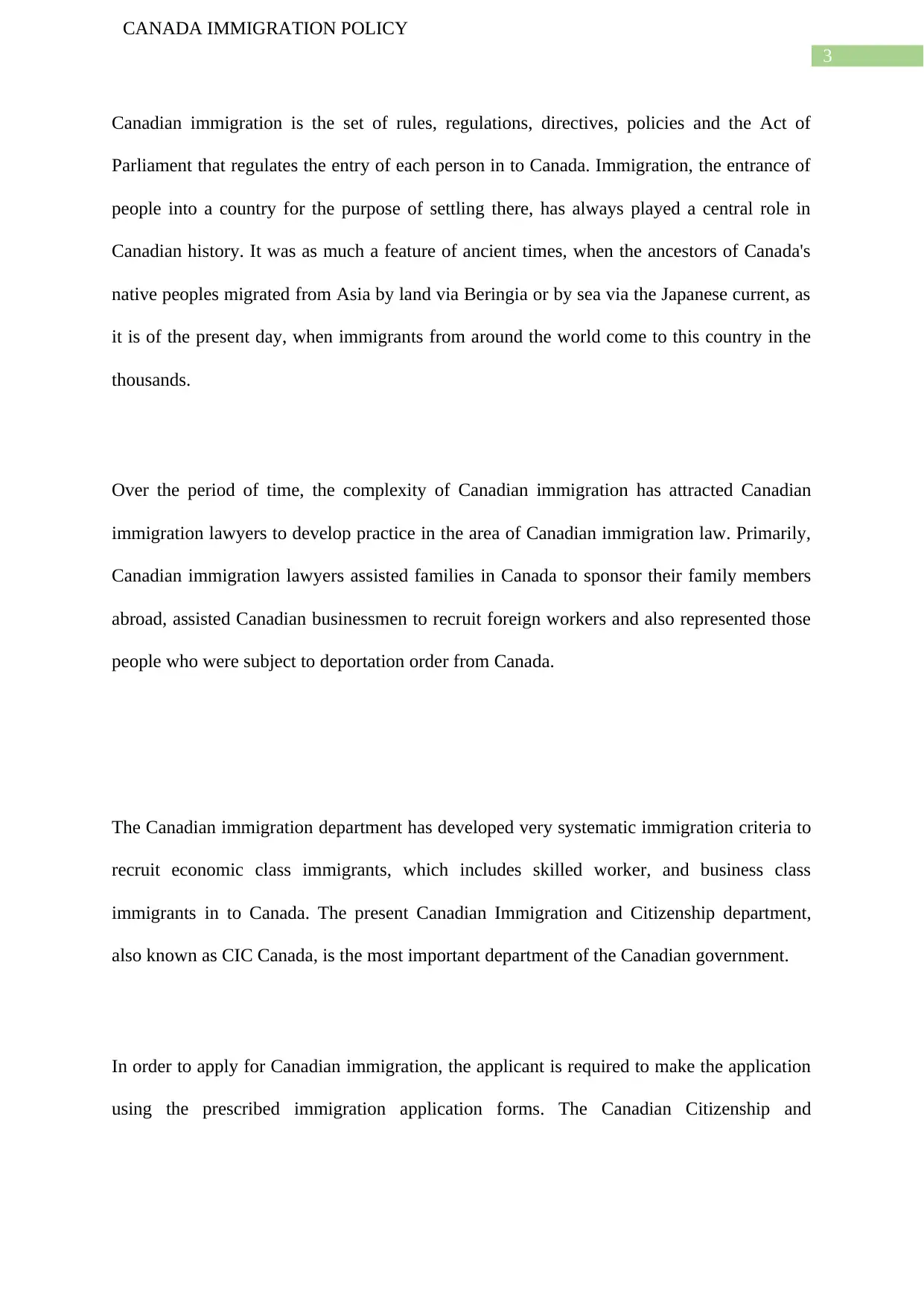
3
CANADA IMMIGRATION POLICY
Canadian immigration is the set of rules, regulations, directives, policies and the Act of
Parliament that regulates the entry of each person in to Canada. Immigration, the entrance of
people into a country for the purpose of settling there, has always played a central role in
Canadian history. It was as much a feature of ancient times, when the ancestors of Canada's
native peoples migrated from Asia by land via Beringia or by sea via the Japanese current, as
it is of the present day, when immigrants from around the world come to this country in the
thousands.
Over the period of time, the complexity of Canadian immigration has attracted Canadian
immigration lawyers to develop practice in the area of Canadian immigration law. Primarily,
Canadian immigration lawyers assisted families in Canada to sponsor their family members
abroad, assisted Canadian businessmen to recruit foreign workers and also represented those
people who were subject to deportation order from Canada.
The Canadian immigration department has developed very systematic immigration criteria to
recruit economic class immigrants, which includes skilled worker, and business class
immigrants in to Canada. The present Canadian Immigration and Citizenship department,
also known as CIC Canada, is the most important department of the Canadian government.
In order to apply for Canadian immigration, the applicant is required to make the application
using the prescribed immigration application forms. The Canadian Citizenship and
CANADA IMMIGRATION POLICY
Canadian immigration is the set of rules, regulations, directives, policies and the Act of
Parliament that regulates the entry of each person in to Canada. Immigration, the entrance of
people into a country for the purpose of settling there, has always played a central role in
Canadian history. It was as much a feature of ancient times, when the ancestors of Canada's
native peoples migrated from Asia by land via Beringia or by sea via the Japanese current, as
it is of the present day, when immigrants from around the world come to this country in the
thousands.
Over the period of time, the complexity of Canadian immigration has attracted Canadian
immigration lawyers to develop practice in the area of Canadian immigration law. Primarily,
Canadian immigration lawyers assisted families in Canada to sponsor their family members
abroad, assisted Canadian businessmen to recruit foreign workers and also represented those
people who were subject to deportation order from Canada.
The Canadian immigration department has developed very systematic immigration criteria to
recruit economic class immigrants, which includes skilled worker, and business class
immigrants in to Canada. The present Canadian Immigration and Citizenship department,
also known as CIC Canada, is the most important department of the Canadian government.
In order to apply for Canadian immigration, the applicant is required to make the application
using the prescribed immigration application forms. The Canadian Citizenship and
Paraphrase This Document
Need a fresh take? Get an instant paraphrase of this document with our AI Paraphraser
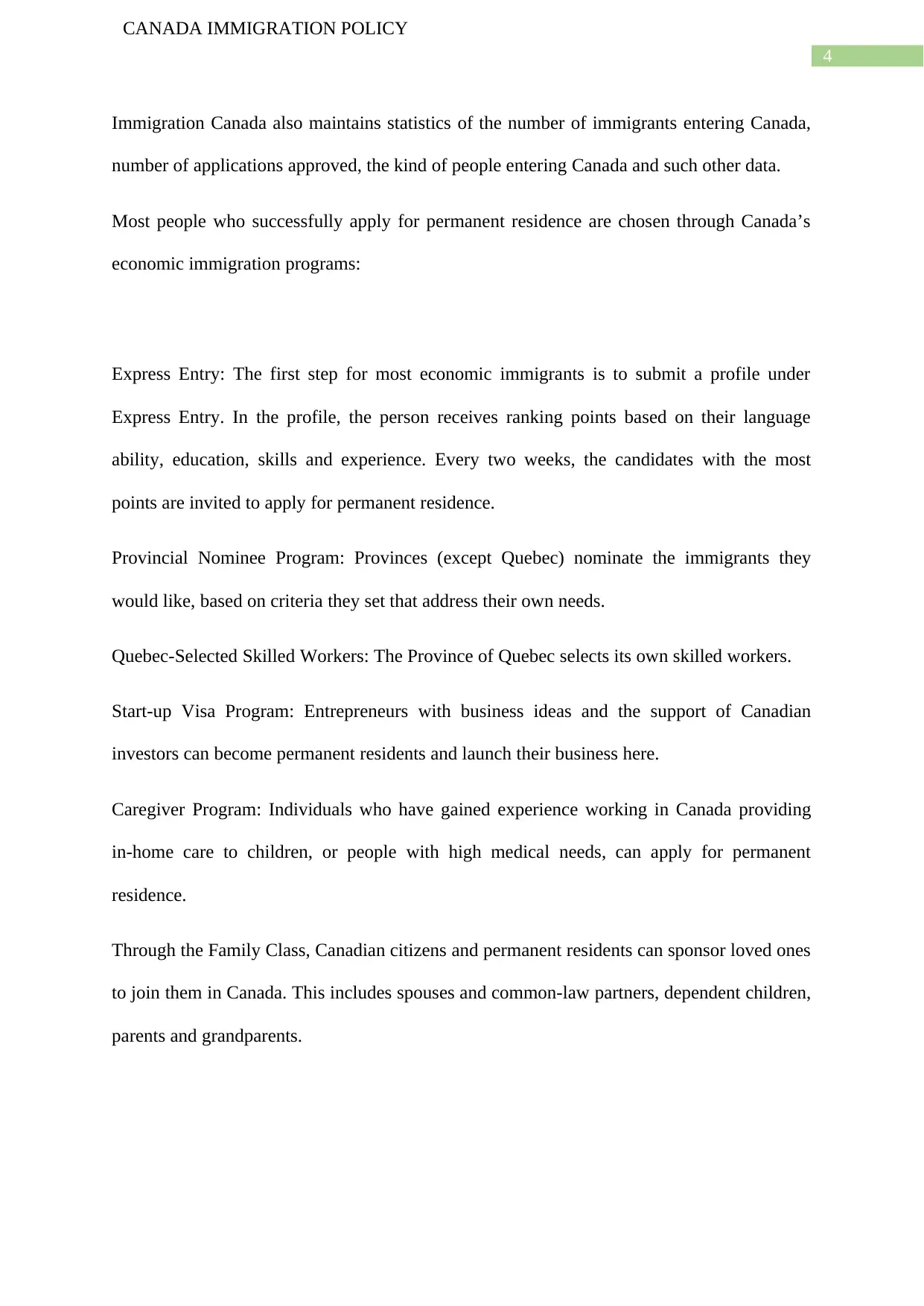
4
CANADA IMMIGRATION POLICY
Immigration Canada also maintains statistics of the number of immigrants entering Canada,
number of applications approved, the kind of people entering Canada and such other data.
Most people who successfully apply for permanent residence are chosen through Canada’s
economic immigration programs:
Express Entry: The first step for most economic immigrants is to submit a profile under
Express Entry. In the profile, the person receives ranking points based on their language
ability, education, skills and experience. Every two weeks, the candidates with the most
points are invited to apply for permanent residence.
Provincial Nominee Program: Provinces (except Quebec) nominate the immigrants they
would like, based on criteria they set that address their own needs.
Quebec-Selected Skilled Workers: The Province of Quebec selects its own skilled workers.
Start-up Visa Program: Entrepreneurs with business ideas and the support of Canadian
investors can become permanent residents and launch their business here.
Caregiver Program: Individuals who have gained experience working in Canada providing
in-home care to children, or people with high medical needs, can apply for permanent
residence.
Through the Family Class, Canadian citizens and permanent residents can sponsor loved ones
to join them in Canada. This includes spouses and common-law partners, dependent children,
parents and grandparents.
CANADA IMMIGRATION POLICY
Immigration Canada also maintains statistics of the number of immigrants entering Canada,
number of applications approved, the kind of people entering Canada and such other data.
Most people who successfully apply for permanent residence are chosen through Canada’s
economic immigration programs:
Express Entry: The first step for most economic immigrants is to submit a profile under
Express Entry. In the profile, the person receives ranking points based on their language
ability, education, skills and experience. Every two weeks, the candidates with the most
points are invited to apply for permanent residence.
Provincial Nominee Program: Provinces (except Quebec) nominate the immigrants they
would like, based on criteria they set that address their own needs.
Quebec-Selected Skilled Workers: The Province of Quebec selects its own skilled workers.
Start-up Visa Program: Entrepreneurs with business ideas and the support of Canadian
investors can become permanent residents and launch their business here.
Caregiver Program: Individuals who have gained experience working in Canada providing
in-home care to children, or people with high medical needs, can apply for permanent
residence.
Through the Family Class, Canadian citizens and permanent residents can sponsor loved ones
to join them in Canada. This includes spouses and common-law partners, dependent children,
parents and grandparents.
1 out of 5
Related Documents
Your All-in-One AI-Powered Toolkit for Academic Success.
+13062052269
info@desklib.com
Available 24*7 on WhatsApp / Email
![[object Object]](/_next/static/media/star-bottom.7253800d.svg)
Unlock your academic potential
Copyright © 2020–2025 A2Z Services. All Rights Reserved. Developed and managed by ZUCOL.





